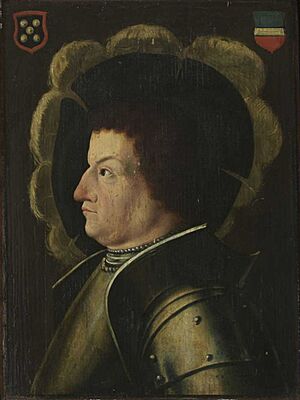Franz von Sickingen facts for kids
Quick facts for kids
Franz von Sickingen
|
|
|---|---|
 |
|
| Born | 2 March 1481 Ebernburg Castle |
| Died | 7 May 1523 (aged 42) Nanstein Castle |
| Buried | Chapel of St. Mary (present-day St. Andreas-Kirche), Landstuhl |
| Noble family | Sickingen |
| Spouse(s) |
Hedwig von Flersheim
(m. 1500; died 1516) |
| Father | Schweickhardt von Sickingen |
| Mother | Margarethe Puller von der Hohenburg |
| Signature |  |
| Memorials | Hutten-Sickingen Monument |
| Military service | |
| Allegiance | Holy Roman Empire |
| Wars | "Knights' War" † |
Franz von Sickingen (born March 2, 1481 – died May 7, 1523) was a powerful knight in the Holy Roman Empire. He is famous for leading the "Knights' War" alongside Ulrich von Hutten. Franz von Sickingen was also an important figure during the early years of the Protestant Reformation. People sometimes called him "the last knight," a title he shared with other brave warriors of his time.
Contents
Early Life and Adventures
Franz von Sickingen was born on March 2, 1481, at Ebernburg Castle. This castle was in a region called the Electoral Palatinate, part of the Holy Roman Empire. His parents were Schweickhardt von Sickingen and Margarethe Puller von der Hohenburg. Franz married Hedwig von Flersheim, who passed away in 1515.
In 1508, Franz fought for Emperor Maximilian I against Venice. After this, he inherited a lot of land near the Rhine River. He became even richer and more famous through many private fights. He often helped people who felt they were being treated unfairly.
In 1513, Franz helped a citizen named Balthasar Schlör, who had been forced out of Worms. Franz attacked Worms with 7,000 men. Even though the emperor had forbidden him to do so, he damaged their lands and stopped their trade. He only stopped when his demands were met.
He also fought against Antoine, Duke of Lorraine. He even made Philip I, Landgrave of Hesse, pay him a large sum of money. In 1518, he got involved in a conflict in Metz. He sided with the citizens against the city's rulers. He led an army of 20,000 soldiers and forced the rulers to pay him money and pay his troops.
Later in 1518, Emperor Maximilian removed the ban against Franz. Franz then joined a war against Ulrich, Duke of Württemberg, as part of the Swabian League.
Supporting the Emperor and Reformers
When Emperor Maximilian died in 1519, there was a competition to choose the next emperor. Franz von Sickingen took money from King Francis I of France. However, when it was time to vote, he led his troops to Frankfurt. Their presence helped make Charles V the new emperor. Because of this, Franz was made an imperial chamberlain and advisor. In 1521, he led an army into France. They caused damage in Picardy but were stopped at Mézières and had to retreat.
Around 1517, Franz von Sickingen met Ulrich von Hutten. Franz supported Hutten's ideas. He often helped people get money that was owed to them by powerful debtors. Even though he wasn't a scholar, he liked learning and protected educated people. In 1519, his threats helped free Johann Reuchlin from his enemies, the Dominicans of Cologne. Franz's castles became a safe place for many reformers, including Martin Luther.
The Knights' War
After the failed trip to France, Sickingen and Hutten came up with a big plan. They wanted to reduce the power of the church leaders and increase the power of the knights. This plan led to the "Knights' War." They hoped to get help from towns and farmers, and also improve their own position.
Soon, a large army was gathered. Many nobles from the upper Rhineland joined them. In August 1522, at Landau, Sickingen was officially named the commander. He declared war on his old enemy, Richard Greiffenklau zu Vollraths, who was the Archbishop of Trier. Sickingen marched his army towards Trier.
However, Trier remained loyal to its archbishop. The landgrave of Hesse and Louis V, count palatine of the Rhine, quickly came to help the archbishop. Sickingen did not get the help he needed and had to retreat to his castle, Nanstein Castle, which was above Landstuhl.
Siege of Nanstein Castle
On October 22, 1522, the ruling council declared Franz von Sickingen an outlaw. In the spring of 1523, he responded by attacking and looting Kaiserslautern. The Archbishop of Trier, Palatine Elector Louis V, and the Landgrave of Hesse decided to move against him. They got help from the Swabian League and marched on Nanstein Castle.
Franz refused to give up. During the siege, he was badly wounded. This siege was one of the first times that powerful artillery was used in battle. The cannons quickly made holes in the castle walls, which were usually very strong. On May 6, 1523, Sickingen was forced to surrender. He died the very next day. He was buried in the old Mary's Chapel, which is now called St. Andreas-Kirche, in Landstuhl.
Family
Franz von Sickingen had six children, including two sons. His sons were Schweikhard von Sickingen zu Neuenbürg (1500-1562) and Franz Conrad (1511-1575). Franz Conrad was later made a baron of the Empire by Emperor Maximilian II.
Memorials
In 1889, a monument was built in Bad Münster am Stein-Ebernburg in Rhineland-Palatinate, Germany. This monument, called the Hutten-Sickingen Monument, honors both Hutten and Sickingen for their roles in the Knights' War.
See also
 In Spanish: Franz von Sickingen para niños
In Spanish: Franz von Sickingen para niños


